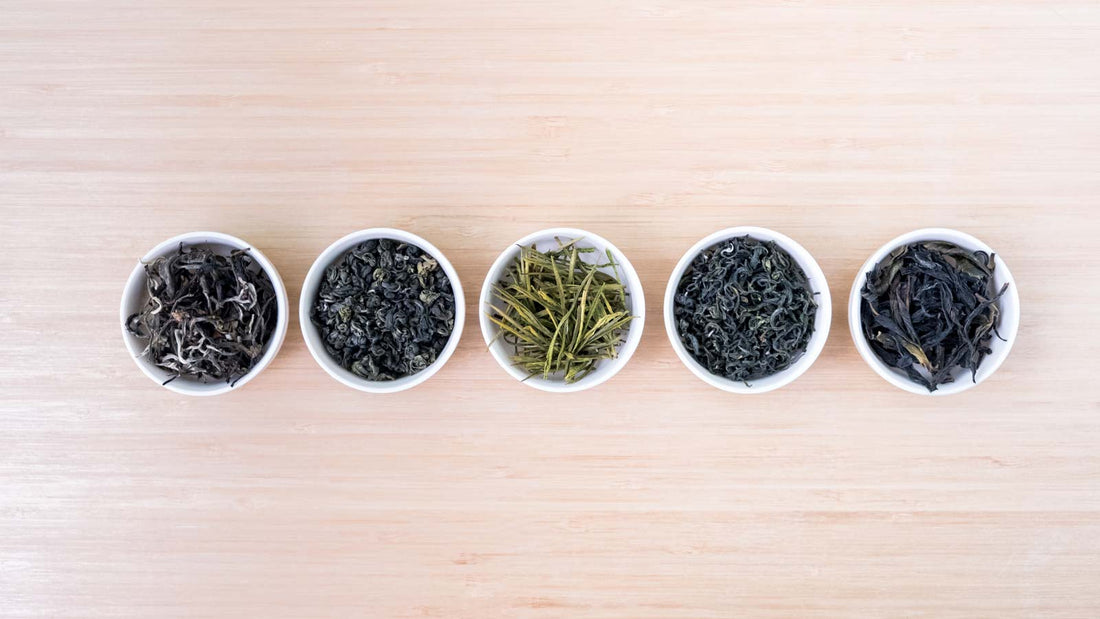Our Vol. 4 Exploration Kit have teas that are refreshing, cooling and light. It contains a tea that has taken up the tea world by storm, despite having a not so elegant name. We will also travel to Nepal and explore the green and white teas from this less-known tea region. Check out our tea stories below to learn more about what's in your cup.
Ana's Green
Anji Baicha
Rizhao Green
Ya Shi Xiang, Phoenix Dancong
Rara Willow White
Here's a map to give you an idea of the journey this Exploration Kit will take you. Locations are approximate and intended to serve as a visual guide only.
Ana's Green

Green Tea
1st flush 2019
Maipokhari, Ilam, Nepal
Green tea is such a dominating tea genre for the Asian tea regions. Afterall, many people enjoy their first green in the form of Longjing or Matcha. Nepal might not ring a bell when it comes to fine loose leaf tea, yet this Ana’s Green from the high elevation Himalayan range is determined to change that.
Notes: Vegetal, Sweet
Gongfu:
3g | 100ml | 75c | 15 secs
Western:
2g | 250ml | 75c | 1 min
This Ana’s Green was the first flush from the Maipokahari Hills of Ilam, one of the four major high altitude districts that produce orthodox/whole leaf tea in Nepal. Consisted of 1 bud and 2 leaves, Ana’s Green is picked by hands to ensure its delicate aromatic vegetal flavor is well preserved in your brew.
The story of Nepali tea
In the long tea history, Nepal is considered a young tea growing nation. It was believed that the first tea plants were gifts from China to the Nepal’s Prime Minister June Bahadur Rana, and shortly after Ilam Tea Estate was established in 1863. Yet with political turmoil, the tea industry failed to strive.
Luckily, the situation finally turned around in the 50s with inflow of public and private investment, as well as support from the government, made it possible for the industry to flourish. Fast forward to today, quintessential Nepali tea is brewed around the world.
Anji Baicha

Green Tea
Spring 2021
Anji, Zhejiang, China
Tea names can sometimes be misleading, as seen in the case of this green tea. Anji Baicha is often mistaken as a white tea because in its name, which clearly said it is a Baicha/ 白茶/White Tea. But defined by the way its processed, it is a green tea through and through. Confusion aside, the tea keeps gaining traction in the tea world as it’s high level of amino acid makes it a highly delectable green tea with a very smooth mouthfeel.
Notes: Sweet, Floral
Gongfu:
3g | 100ml | 80c | 20 secs
Western:
2g | 250ml | 80c | 1 min
This Anji Baicha is harvested just this April. Consisted of 1 bud and 1-2 leaves, you can see different shades of green. The mouthfeel of this tea is extremely smooth and sweet with very little astringency, which sometimes makes it hard to believe it’s a green tea. And it’s high level of animo acid is also said to have great benefits on skin.
The story of Anji Baicha
Anji Baicha tea bush was first spotted in the 30s but disappeared shortly after. It was until the 70s and 80s that locals rediscovered some old bushes which became the mother bush of the Anji Baicha cultivar – Baiye No. 1, and the rest is history.
Anji Baicha is called a “white tea” because of it’s whitish leaves. Its fresh leaves are sensitive to temperature and retain a white tint if the temperature is below 22c. Once temperature rises, the leaves turns green again. Tea farmers have a window of less than 30 days to pick the tea while it’s still white to capture the sweetness. So don’t forget to admire the pale green tea leaves after they are brewed.
Rizhao Green

日照綠茶
Green Tea
Spring 2021
Rizhao, Shandong, China
Who doesn’t love a rule breaker? Rizhao Green is grown in Shangdong, the Northernmost tea region of China. The harsh wintery climate acts as a wonderful cradle in cultivating a unique green tea with a hint of pea sweetness.
Notes: Savory-Sweet, Nutty
Gongfu:
4g | 100ml | 80c | 15-20 secs
Western:
4g | 250ml | 80c | 2 mins
This Rizhao Green is a post Qingming harvest. Many tea lovers chase after pre-Qingming tea in most tea regions in the south, but not in Rizhao*. The prolong period of cold climate forces the tea to grow at a much slower pace, giving it ample time to develop its taste. We are often surprised by how much flavor is pack in these tiny leaves.
The story of Rizhao Tea
After the success in establishing tea plantation up north to Laoshan in the 50s, other northern regions such as Rizhao joined in. 1966 marked the year for Rizhao to declare initial success, but it was not until the late 90s when green tea production eventually became one of the main agricultural products for the area.
*Pre-Qingming tea in Rizhao also exists but usually is grown in green house instead of outdoor. This is due to the time-honoured “pre-Qingming tea = fine tea” concept that some Rizhao farmers feel the urge to compete with.
Ya Shi Xiang, Phoenix Dancong


鴨屎香
Oolong Tea
Spring 2021
Wudong, Guangdong, China
If you have tasted our very first Tea Exploration Kit, you might remember the very aromatic Milan Xiang and its addictive fragrant quality. In this volume, we present to you another tea from the Phoenix Dancong family – Ya Shi Xiang, which translates into Duck Sh*t Aroma, literally.
Notes: Floral, Sweet
Gongfu:
5g | 100ml | 98c | 5 secs
Western:
3g | 250ml | 95c | 2 mins
This Ya Shi Xiang is hand crafted by the same family farm in Wudong Village which we featured in Vol 1. This tea producer has been producing Phoenix Dancong for 80 years and is proud to preserve the cultivating and hand crafting traditions for their teas. The producer is able to capture the unique aroma from different varietal of Phoenix Oolong and enhance it through his crafty processing. Receiving tea packages from them is always a joy as the moment the box is opened, the hypnotic aroma would ooze out despite the tea being tightly sealed in double bags.
The story of Duck Sh*t Oolong
Traditionally, Phoenix Oolong was picked and processed individually from a single tea bush (Dancong) to preserve the unique flavor and characteristic of each cultivar. So how did a delightful tea get such a name? There are many versions of the origin and we like this one the most: a tea farmer chanced upon the Duck Sh*t Oolong tea bushes. Naturally, its unique floral aroma and honey like flavor captivated many tea lovers and attracted unwanted attention. Trying to protect his trade secret he decided to downplay it by giving it an unattractive name.
We don’t blame him for trying. We are glad that his plan did not work and the tea cultivar spread like wild fire for our enjoyment.
Rara Willow White

White Tea
2nd Flush 2020
Maipokhari, Ilam, Nepal
White tea is becoming the favorite tea type in the last decade as people are falling for its delicate floral sweetness. With minimal processing to manipulate the flavor, the taste depends heavily on the quality of the tea leaves, and this Rara Willow White is definitely living up to its 7,500ft elevation promise.
Notes: Stone Fruit, Floral
Gongfu:
3g | 100ml | 80c | 15 secs
Western:
2g | 250ml | 75c | 1 min
This Rara Willow White is 2nd flush harvest in 2020, consisted of only one bud and one leaf. With deep respect to nature, tea pickers hand plucked the tea early in the morning and late afternoon to avoid the scotching sun, resulting in a crisp and delicate yet flavorful tea in a cheerful yellow liquor that keeps you coming back for more.
More story of Nepali Tea
In the past, majority of Nepali tea production was mass produced CTC (cut, tear, curl) tea from the lowlands as a low-price commodity. Yet having a comparable climate and growing conditions as Darjeeling in their high elevation regions (Fun fact: Ilam is merely 80km south-west of Darjeeling), many fine quality Nepali whole leaf teas were shipped to Darjeeling and passed as the world renown Champagne of Tea to fulfil market demand.
With the effort of public and private investors, Nepali tea is slowly walking out of the shadow and gaining more recognition on its own. As a late bloomer, Nepal still has a long way to go but it is definitely one that should be under your tea radar.

